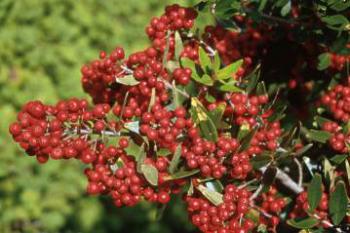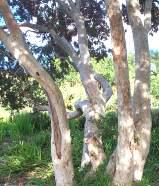Olinia emarginata
Olinia emarginata Thunb.
Family: Oliniaceae
Common names: mountain hard pear (Eng.); berghardpeer (Afr.)
SA Tree No: 514
Introduction
Olinia emarginata is a small to medium-sized evergreen tree, with attractive flowers and berries which makes for an attractive garden ornamental, however propagation of this tree is very difficult.

Description
Description
It can be a single- or multi-stemmed tree, with glossy green foliage which forms a nice round crown. This tree is fast-growing and frost-tolerant. It has a straight, smoothish, grey or creamy-white trunk, sometimes mottled or marked with orange.

The leaves are glossy dark green above, pale green and dull below, they are hairless and give off a faint smell of almonds when crushed, indicating the release of cyanide. The leaves are opposite, simple, entire-margined, oblong to lanceolate. The tip of the leaves is rounded, notched and is usually tinged with pink or red.
The flowers are very small, pale to dark pink in colour, and are slightly fragrant. Flowers are in loose, axillary heads that are usually more than half as long as the leaves. Flowering time is from spring to summer. After flowering, the tree forms clusters of small round fruit which turn red in autumn and hang on the tree until well into winter. These attract birds to the garden.
Conservation Status
Status
This is a small family of about ten species of trees and shrubs endemic to southern and eastern Africa of which Olinia is the only genus. In the past there has been a great deal of confusion in identifying the species. This is because the species tend to resemble one another in leaf characters. The specific name is from the Latin 'emarginatus', meaning 'notched', in reference to the typically notched tips of the leaves.
Distribution and habitat
Distribution description
Olinia emarginata originates in Kwa-Zulu Natal, the Drakensberg and Gauteng, where it is fairly widespread. It grows in mountain forests, in kloofs and gullies, in protected wooded ravines and riverine fringes, and occasionally on rocky hill slopes in high-altitude grasslands.
Derivation of name and historical aspects
History
This is a small family of about ten species of trees and shrubs endemic to southern and eastern Africa of which Olinia is the only genus. In the past there has been a great deal of confusion in identifying the species. This is because the species tend to resemble one another in leaf characters. The specific name is from the Latin 'emarginatus', meaning 'notched', in reference to the typically notched tips of the leaves.

Growing Olinia emarginata
Grow
This is a very difficult species to propagate, from either seed or cuttings. Numerous techniques have been tried, with air layering giving the best results. Seed can be sown in a 1:1 mixture of river sand and compost. Germination is erratic and can take up to nine months. Do not allow the mixture to dry out at any stage. Olinia emarginata can withstand frost, but not drought.
Credits
Berenice Carolus
Kirstenbosch Garden
May 2001
Plant Attributes:
Plant Type: Tree
SA Distribution: Free State, Gauteng, KwaZulu-Natal
Soil type: Sandy
Flowering season: Spring, Early Summer
PH: Acid
Flower colour: Pink
Aspect: Full Sun
Gardening skill: Challenging
Special Features:
Horticultural zones










Rate this article
Article well written and informative
Rate this plant
Is this an interesting plant?
Login to add your Comment
Back to topNot registered yet? Click here to register.